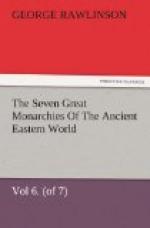the cavalry. Perhaps nothing short of an invasion
of his country by the Parthian king in person would
have prevented Artavasdes from detaching a portion
of his troops to act in Mesopotamia. And no doubt
it is also true that Orodes had great confidence in
his general, whom he may even have felt to be a better
commander than himself. Surenas, as we must call
him, since his name has not been preserved to us,
was in all respects a person of the highest consideration.
He was the second man in the kingdom for birth, wealth,
and reputation. In courage and ability he excelled
all his countrymen; and he had the physical advantages
of commanding height and great personal beauty.
When he went to battle, he was accompanied by a train
of a thousand camels, which carried his baggage; and
the concubines in attendance on him required for their
conveyance two hundred chariots. A thousand horseman
clad in mail, and a still greater number of light-armed,
formed his bodyguard. At the coronation of a
Parthian monarch, it was his hereditary right to place
the diadem on the brow of the new sovereign.
When Orodes was driven into banishment it was he who
brought him back to Parthia in triumph. When
Seleucia revolted, it was he who at the assault first
mounted the breach and, striking terror into the defenders,
took the city. Though less than thirty years
of age at the time when he was appointed commander,
he was believed to possess, besides these various
qualifications, consummate prudence and sagacity.
The force which Orodes committed to his brave and
skillful lieutenant consisted entirely of horse.
This was not the ordinary character of a Parthian
army, which often comprised four or five times as many
infantry as cavalry. It was, perhaps, rather
fortunate accident than profound calculation that
caused the sole employment against the Romans of this
arm. The foot soldiers were needed for the rough
warfare of the Armenian mountains; the horse would,
it was known, act with fair effect in the comparatively
open and level Mesopotamia. As the king wanted
the footmen he took them, and left to his general
the troops which were not required for his own operations.
The Parthian horse, like the Persian, was of two kinds,
standing in strong contrast the one to the other.
The bulk of their cavalry was of the lightest and
most agile description. Fleet and active coursers,
with scarcely any caparison but a headstall and a
single rein, were mounted by riders clad only in a
tunic and trousers, and armed with nothing but a strong
bow and a quiver full of arrows. A training begun
in early boyhood made the rider almost one with his
steed; and he could use his weapons with equal ease
and effect whether his horse was stationary or at
full gallop, and whether he was advancing towards or
hurriedly retreating from his enemy. His supply
of missiles was almost inexhaustible, for when he
found his quiver empty, he had only to retire a short
distance and replenish his stock from magazines, borne




